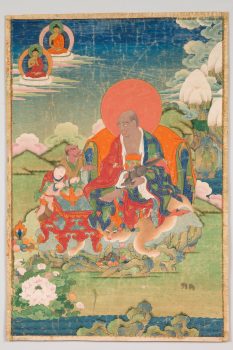Tibet
late 19th or 20th century


Tibet
late 19th or 20th century


The genre of the sixteen arhats was adopted from China, and blue green landscapes are an integral part of these paintings. In Tibetan depictions of this genre the landscape opened up more and more over time, and in this version only the rocky outcrop on which the arhat is seated remains as a reflection of the Chinese model. The diagonal composition indicates that this painting was part of a set, with the arhat facing the direction of what would have been a central painting of the Buddha. It can be deduced that this painting is a rather recent production by the realistic rendering of two small gray elephants in the foreground. Advanced in age, as typical of the group of sixteen arhats, Bakula is shown wearing loose monastic robes in red, green, and blue. He holds a brown mongoose with both hands, which ejects wish fulfilling jewels from its mouth. The pearls around the rock, the snow capped mountains in the background, the abundance of water, and the peony in the foreground are indicators of an auspicious setting. Two pairs of small animals–snow lions on top of the mountains and elephants in the foreground–further emphasize this theme. In the top left corner are two buddhas from the set of the “Thirty five Buddhas of Confession,” Ratnaprabha and Nagaraja.
In Buddhism merit is accumulated through engaging in positive actions that lead to positive results, such as better rebirths. Buddhists gain merit by making offerings, donating to those in need, reciting mantras, and other good deeds.
Himalayan art includes portraits of legendary and historical humans, including accomplished religious teachers (lamas), the Buddha’s original disciples (arhats), and spiritually accomplished tantric masters (mahasiddhas).
Today, Tibetans primarily inhabit the Tibetan Plateau, situated between the Himalayan mountain range and the Indian subcontinent to the west, Chinese cultural regions to the east, and Mongolian cultural regions to the northeast. During the 7th to 9th century, Tibetan rulers expanded their empire across Central Asia, and established Buddhism as the state religion.
Get the latest news and stories from the Rubin, plus occasional information on how to support our work.